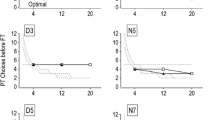Abstract
The present study is a mixed design that examines instruction following, with the accuracy of instructions varied across phases within subjects and the schedule of reinforcement varied across six groups. A choice experiment was conducted in which subjects were provided with instructions that varied systematically in their accuracy. Across phases, the accuracy of instructions (expressed in percentages) was either 0-50-100-50-0 or 100-50-0-50-100. Across groups, the schedule of reinforcement was one of the following: continuous, Fixed Ratio 2, or Fixed Ratio 3. With continuous reinforcement, subjects showed collateral consequence control and either followed or disobeyed instructions, in keeping with the predictions of reinforcement theory. When the schedule of reinforcement was leaned, however, insensitivity was observed. The implications of the results for the controversies regarding the concept of rule-governed behavior are discussed.
Similar content being viewed by others
References
AYLLON, T., & AZRIN, N. H. (1964). Reinforcement and instructions with mental patients. Journal of the Experimental Analysis of Behavior, 7, 327–331.
BARON, A., & GALIZIO, M. (1983). Instructional control of human operant behavior. The Psychological Record, 33, 495–520.
BUSKIST, W. R., BENNETT, R. H., & MILLER, H. L., Jr. (1981). Effects of instructional constraints on human fixed-interval performance. Journal of the Experimental Analysis of Behavior, 35, 217–225.
CERUTTI, D. A. (1989). Discrimination theory of rule-governed behavior. Journal of the Experimental Analysis of Behavior, 51, 259–276.
CERUTTI, D. A. (1991). Discriminative versus reinforcing properties of schedules as determinants of schedule insensitivity in humans. The Psychological Record, 41, 51–67.
DEGRANDPRE, R. J., & BUSKIST, W. F. (1991). Effects of accuracy of instructions on human behavior: Correspondence with reinforcement contingencies matters. The Psychological Record, 41, 371–384.
GALIZIO, M. (1979). Contingency-shaped and rule-governed behavior: Instructional control of human loss avoidance. Journal of the Experimental Analysis of Behavior, 31, 53–70.
GLENN, S. S. (1987). Rules as environmental events. The Analysis of Verbal Behavior, 5, 29–32.
HAYES, S. C., BROWNSTEIN, A. J., HAAS, J. R., & GREENWAY, D. E. (1986). Instructions, multiple schedules, and extinction: Distinguishing rule-governed from schedule-controlled behavior. Journal of the Experimental Analysis of Behavior, 46, 137–147.
HAYES, S. C., BROWNSTEIN, A. J., ZETTLE, R. D., ROSENFARB, I., & KORN, Z. (1986). Rule-governed behavior and sensitivity to changing consequences of responding. Journal of the Experimental Analysis of Behavior, 45, 237–256.
HAYES, S. C., ZETTLE, R. D., & ROSENFARB, I. (1989). Rule-following. In S. C. Hayes (Ed.), Rule-governed behavior: Cognition, contingencies, and instructional control (pp. 191–220). New York: Plenum Press.
HIGGINS, S. T., & MORRIS, E. K. (1984). Generality of free-operant avoidance conditioning to human behavior. Psychological Bulletin, 96, 247–272.
JOYCE, J. H., & CHASE, P. N. (1990). Effects of response variability on the sensitivity of rule-governed behavior. Journal of the Experimental Analysis of Behavior, 54, 251–262.
KAUFMAN, A., BARON, A., & KOPP, R. E. (1966). Some effects of instructions on human operant behavior. Psychonomic Monograph Supplements, 1, 243–250.
LIPPMAN, L. G., & MEYER, M. E. (1967). Fixed-interval performance as related to instructions and subjects’ verbalizations of the contingency. Psychonomic Science, 8, 135–136.
LOWE, C. F. (1979). Determinants of human operant behavior. In M. D. Zeiler & P. Harzem (Eds.), Advances in analysis of behaviour: Vol. 1. Reinforcement and the organization of behaviour (pp. 159–192). New York: John Wiley and Sons.
MATTHEWS, B. A., CATANIA, A. C., & SHIMOFF, E. (1985). Effects of uninstructed verbal behavior on nonverbal responding: Contingency descriptions versus performance descriptions. Journal of the Experimental Analysis of Behavior, 43, 155–164.
MATTHEWS, B. A., SHIMOFF, E., CATANIA, A. C., & SAGVOLDEN, T. (1977). Uninstructed human responding: Sensitivity to ratio and interval schedules. Journal of the Experimental Analysis of Behavior, 27, 453–467.
MICHAEL, J. J. (1984). Verbal behavior. Journal of the Experimental Analysis of Behavior, 42, 363–376.
NEWMAN, B., BUFFINGTON, D. M., & HEMMES, N. S. (1991). Maximization of reinforcement by two autistic students with accurate and inaccurate instructions. Analysis of Verbal Behavior, 9, 41–48.
REESE, H. W. (1989). Rules and rule-governance: Cognitive and behavioristic views. In S. C. Hayes (Ed.), Rule-governed behavior: Cognition, contingencies, and instructional control (pp. 3–84). New York: Plenum Press.
ROSENFARB, I. S., NEWLAND, M. C., BRANNON, S. E., & HOWEY, D. S. (1992). Effects of self-generated rules on the development of schedule controlled behavior. Journal of the Experimental Analysis of Behavior, 58, 107–121.
SHIMOFF, E., CATANIA, A. C., & MATTHEWS, B. A. (1981). Uninstructed human responding: Responsivity of low-rate performance to schedule contingencies. Journal of the Experimental Analysis of Behavior, 36, 207–220.
SHIMOFF, E., MATTHEWS, B. A., & CATANIA, A. C. (1986). Human operant performance: Sensitivity and pseudosensitivity to contingencies. Journal of the Experimental Analysis of Behavior, 46, 149–157.
VAUGHAN, M. (1989). Rule-governed behavior in behavior analysis. In S. C. Hayes (Ed.), Rule-governed behavior: Cognition contingencies, and instructional control (pp. 97–118). New York: Plenum Press.
WANCHISEN, B. A., TATHAM, T. A., & HINELINE, P. N. (1992). Human choice in “counterintuitive” situations: Fixed- versus progressive-ratio schedules. Journal of the Experimental Analysis of Behavior, 58, 67–85.
WEINER, H. (1970). Instructional control of human operant responding during extinction following fixed-ratio conditioning. Journal of the Experimental Analysis of Behavior, 13, 391–394.
Author information
Authors and Affiliations
Rights and permissions
About this article
Cite this article
Newman, B., Buffington, D.M. & Hemmes, N.S. The Effects of Schedules of Reinforcement on Instruction Following. Psychol Rec 45, 463–476 (1995). https://doi.org/10.1007/BF03395155
Published:
Issue Date:
DOI: https://doi.org/10.1007/BF03395155




